Lipoma- Meaning, Types, Causes, Symptoms, Treatment & Cost
Lipoma is the deposition of fats at a particular location, forming a tender lump under your skin. In most people, it stays as if it is lifelong. However, in some cases, it slowly develops and enlarges. It may lead to pain, bowel obstructions, and pressing underlying nerves or blood vessels.
If the lipoma is disrupting or irritating you, then you must consult your doctor.

WHAT IS LIPOMA
A lipoma is a slow-growing, fatty lump that's situated between your skin and the underlying muscle layer. A lipoma can form on any part of the body, but they typically appear on the neck, shoulders, forearms, and thighs.
Most of the time people live with Lipomas and sometimes they don’t even observe this abnormality. Though, it is true that many times lipomas do not require to be treated but it disrupts your appearance and may increase in size if not treated. However, this can easily be removed or eliminated by your doctor.

TYPES OF LIPOMA
Conventional Lipoma
Conventional Lipoma is the most common form of all the lipomas, in which white fat cells get accumulated.
1
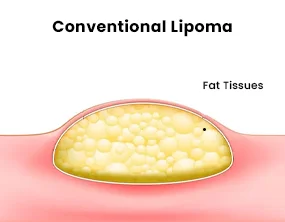
Spindle cell lipomas
Spindle cell lipomas is the rare form of lipoma, which grow slowly and are considered as benign lipomatous tumors.
2

Pleomorphic lipomas
Pleomorphic lipomas is a rare lipoma, in which the accumulated adipocytes show variable shapes and components, including spindle like cells.
3

Myelolipoma
Myelolipoma is the lipoma in which mature adipocytes and islands of hematopoietic elements are accumulated in the adrenal glands.
4
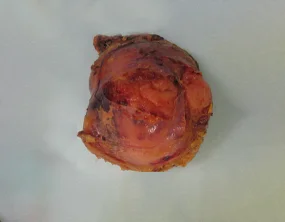
Fibrolipoma
Fibrolipoma are the soft tissue lipomas developed from mature adipose cells of oral cavity.
5
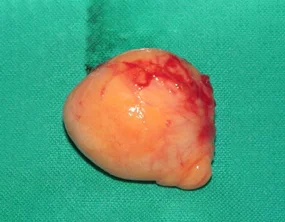
Angiolipoma
Angiolipoma or rubbery tumor can develop under the skin along with the blood vessels.
6
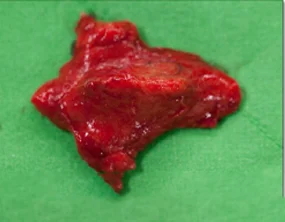
CAUSES
- Inherited within the family
- Madelung’s Disease (unusual fat accumulation)
- Gardner Syndrome (colorectal polyps develop)
- Dercum’s Ailment (Growths of fatty tissues)
HOW IS IT FORMED
Lipoma is a type of benign tumor that develops when fat cells grow and multiply rapidly in a localized area. The exact cause of lipoma formation is still not fully understood, but it is believed to be linked to a combination of genetic and environmental factors.
Some studies suggest that injury or trauma to a specific area of the body may also contribute to the formation of lipomas. Lipomas are typically slow-growing and painless, and they can occur anywhere on the body mainly where there is fat tissue.
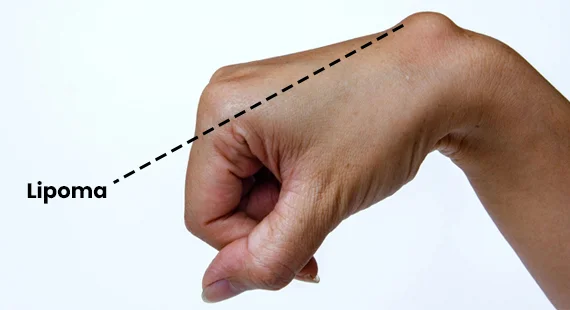
SYMPTOMS
- Fatty lump that does not spread
- A lump that can move on touching
- Oval or round shaped rubbery tissues
- Rapid growth or increase in size of the lipoma
- Pain or tenderness around the lipoma
- Swelling, redness, or inflammation of the lipoma or surrounding tissue
- Ulceration or bleeding from the lipoma

DIAGNOSIS
Physical examination
Doctors usually inspect or feel the lump if it is large and painful.
Biopsy
A sample of tissue from the lump is removed in order to check it under microscope.
Imaging tests
Imaging tests like X-ray, MRI, or CT scan is done to look for the depth of the fatty tissue.
DO's
DONT's
TREATMENTS
NON-SURGICAL TREATMENTS
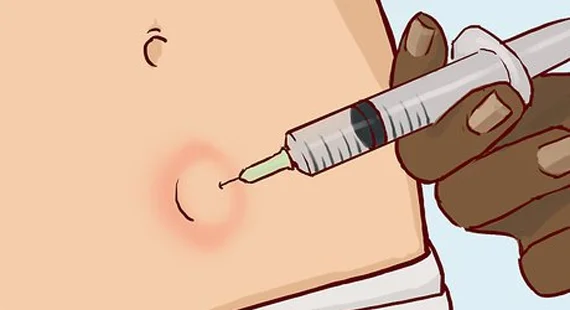
There are several non-surgical treatment options for lipomas, including:
- Steroid injections: Injecting a corticosteroid medication into the lipoma can help to shrink it by reducing inflammation and slowing down the growth of fat cells.
- Liposuction: A minimally invasive procedure that uses a small tube called a cannula to suction out the fatty tissue. This technique is effective for treating lipomas that are soft and movable.
- Cryolipolysis: Also known as fat freezing, this treatment uses cold temperatures to freeze and destroy the fat cells in the lipoma. Over time, the body absorbs and eliminates the destroyed fat cells.
- Laser therapy: Laser treatments use focused heat to destroy the fat cells in the lipoma. This technique is effective for treating smaller lipomas.
- Herbal remedies: Some herbs, such as turmeric, aloe vera, and castor oil, are believed to have anti-inflammatory and therapeutic properties that can help reduce the size of lipomas.
SURGICAL TREATMENTS

Surgical removal is the most common treatment for lipomas. The procedure involves making a small incision in the skin, then cutting and removing the fatty tissue. This is usually performed under local anesthesia and as an outpatient procedure.
There are several surgical techniques used for lipoma removal, including:
- Excision: This involves cutting out the entire lipoma and removing it from the body.
- Minimal excision: This involves making a smaller incision and using a tool to extract the lipoma from the body.
- Endoscopic removal: This involves using a small camera and specialized instruments to remove the lipoma through small incisions in the skin.
Surgical removal is usually effective for treating most types of lipomas, and recurrence is rare.
RISKS AND COMPLICATIONS
A diseased lipoma can pose several risks and complications that may require medical attention. Here are some of the potential risks and complications associated with a diseased lipoma:
Infection: A diseased lipoma can become infected, leading to redness, pain, fever, and other symptoms. In severe cases, the infection can spread to other parts of the body, causing a systemic infection.
Pain and discomfort: As the lipoma grows or becomes inflamed, it can cause pain, discomfort, or a feeling of pressure.
Nerve or muscle compression: A diseased lipoma can grow large enough to press against nerves or muscles, causing numbness, tingling, weakness, or difficulty moving the affected area.
Cancer: While lipomas are typically benign tumors, there is a very small risk that a diseased lipoma could develop into a cancerous tumor.
Cosmetic concerns: A diseased lipoma can change the appearance of the affected area, causing cosmetic concerns or self-consciousness.
If you suspect that you have a diseased lipoma or are experiencing any of these symptoms, it is important to seek medical attention to receive an appropriate diagnosis and treatment. You can contact Glamyo Health for appropriate diagnosis and treatment.
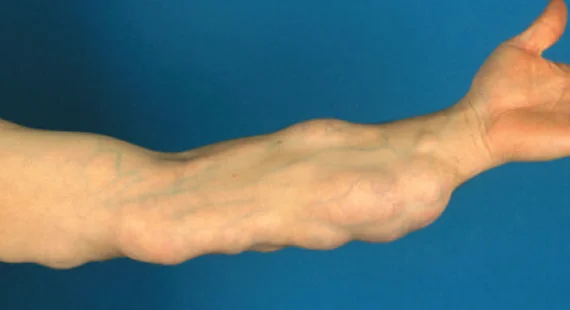
IF LEFT UNTREATED
Some of the lipoma tend to grow continuously if not treated. There are chances that oversized lipoma may compress the surrounding nerves and blood vessels, causing severe health complications.
There are potential possibilities that lipoma may spread to other parts of the body. Generally, lipoma is not a cancer and pose no harm to the body. They must be removed if they are painful or appears to be growing or spreading to other parts of the body.
COST
The cost of Lipoma surgery depends on the degree of lipoma, and the type of surgery opted for removing lipoma. Different hospitals have different price ranges depending on the facilities they provide.
Lipoma Removal surgery costs Rs 20,000 for minor lipoma removal surgery to 50,000.
Financial Options

INSURANCE COVERAGE
Lipoma surgery is a cosmetic procedure that is often not covered under health insurance policies because it is considered an elective surgery. However, some insurance plans may cover the surgery if it is deemed medically necessary due to a hormonal imbalance or other medical conditions that cause lump or tissue enlargement.
If your health insurance plan does not cover lipoma surgery, you will need to pay for the procedure out of pocket. The cost of the surgery can vary depending on various factors, such as the surgeon's experience, the type of anesthesia used, the complexity of the surgery, and the geographic location of the facility.

Reviews
View All
Raj
Lipoma
Hi, my name is Raj Kumar and I had Lipoma on the back. I saw an ad on Facebook, I filled in an enquiry and I got a call back fro read more

 Lipoma | Surgeries
Lipoma | Surgeries Dr. Sahil Singla5
Dr. Sahil Singla5  SRS HOSPITAL - NOIDA
SRS HOSPITAL - NOIDA  New Delhi
New Delhi

Istekhar Ah ...
Lipoma
Hello, my name is Istekhar and I have come to Apollo Hospital through Glamyo Health for Lipoma removal and I got wonderful servi read more

 Lipoma | Surgeries
Lipoma | Surgeries Dr. Nikunj Mody5
Dr. Nikunj Mody5  Apollo Spectra Hospi...
Apollo Spectra Hospi...  Mumbai
Mumbai

APPALA RAJU
Lipoma
Hello, I had a Lipoma removal surgery for which I contacted Glamyo Health team. It was becoming difficult for me to look for a g read more

 Lipoma | Surgeries
Lipoma | Surgeries Dr. Veena Priya D5
Dr. Veena Priya D5  Dr.Ramesh Orthopaedi...4.5 (14)
Dr.Ramesh Orthopaedi...4.5 (14) Hyderabad
Hyderabad

Atul
Lipoma
Hi, my name is Atul, I came here to Parakh hospital through the help of Glamyo Health. Their reference is good and their coordin read more

 Lipoma | Surgeries
Lipoma | Surgeries Dr. Nikunj Mody5
Dr. Nikunj Mody5  Parakh Hospital4.6 (99)
Parakh Hospital4.6 (99) Mumbai
Mumbai

Mr Sarkar
Lipoma
Hello, my name is Krishna, I came here for my father Mr. Sarkar's surgery and my interaction with Glamyo Health regarding the en read more

 Lipoma | Surgeries
Lipoma | Surgeries Dr. Kapil Aggarwal4
Dr. Kapil Aggarwal4  Habilite Clinics
Habilite Clinics  New Delhi
New Delhi

Pawan Yadav
Lipoma
Hello, my name is Pawan, I had my interaction with Glamyo Health through the care insurance team and I had my further coordinati read more

 Lipoma | Surgeries
Lipoma | Surgeries Dr. Tapeshwar Sehgal5
Dr. Tapeshwar Sehgal5  Ayushman Hospital4.1 (68)
Ayushman Hospital4.1 (68) New Delhi
New Delhi

SWAMY
Lipoma
Hi, Glamyo Health services are wonderful. They helped me in finding a good doctor and good hospital. Further, everything related read more

 Lipoma | Surgeries
Lipoma | Surgeries Dr. Veena Priya D5
Dr. Veena Priya D5  lotus hospital lakdi...
lotus hospital lakdi...  Hyderabad
Hyderabad

Ankit
Lipoma
Hi, this is Ankit Gautum and I am from Greater Noida. I just came to know about Glamyo Health through an advertisement and they read more

 Lipoma | Surgeries
Lipoma | Surgeries Dr. Sahil Singla5
Dr. Sahil Singla5  LifeLine Hospital
LifeLine Hospital  New Delhi
New Delhi

Sarfaraj An ...
Lipoma
Hi, my name is Sarfaraj Ansari, I came here for my Lipoma surgery. Miss. Shweta and Danish helped me a lot. The whole treatment read more

 Lipoma | Surgeries
Lipoma | Surgeries Dr. Niraj B. Singh4
Dr. Niraj B. Singh4  Parakh Hospital4.6 (99)
Parakh Hospital4.6 (99) Mumbai
Mumbai

gudiya Jais ...
Lipoma
Hi, my name is Hiralal Jaiswarand I came here for my wife (Gudiya Jaiswar)'s surgery. I got a call from Glamyo Health and they m read more

 Lipoma | Surgeries
Lipoma | Surgeries Dr. Sunny Agarwal5
Dr. Sunny Agarwal5  Parakh Hospital4.6 (99)
Parakh Hospital4.6 (99) Mumbai
Mumbai
Doctors
View AllBlogs
View All
Spindle Cell Lipoma – Details That You Must Know
A rarely found medical condition that isn’t as much known or given attention. The following blog will explore its basics. This includes meaning, causes, symptoms, diagnosis, treatment, and prevention. A simple definition of Spindle Lipoma A spindle lipoma is commonly found developing under the deepest layer of the skin area. It is a rarely found […]

Home Remedies for Lipoma: Natural Treatments for Lipoma
A lipoma is a muscle mass that forms directly within the skin and can be round or oval-shaped. It possesses a high-fat content and slides easily when handled, producing little pain. Lipomas can develop in any body part, but the trunk (torso), back, arms, neck, and shoulders are the most prevalent. Lipoma affects roughly one […]
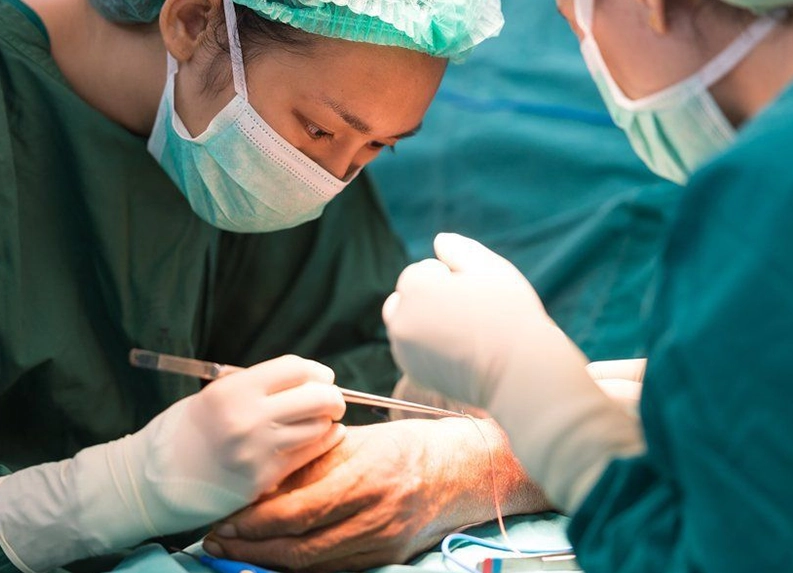
Lipoma – Image Based Case Study
Lipomas are non-cancerous, fatty lumps that grow slowly beneath the skin. These are painless, soft, and moveable under the skin. Lipomas are relatively common, and they can occur at any age, although they tend to appear more frequently in middle-aged people. Lipomas can range in size from very small to several centimeters in diameter, and […]
Know More about Lipoma
Lipoma is a fatty lump that develops beneath the skin. It is often a painless and benign tumor and after becoming lipoma cancer. Most of the time people live with Lipomas and sometimes they don’t even observe this abnormality. Though, it is true that many times lipomas do not require to be treated but it disrupts your appearance and may increase in size if not treated. However, this can easily be removed or eliminated by your doctor.
Glamyo Health is known for minimally invasive surgeries and elective surgeries which makes it suitable for these kinds of treatment. It has been seen that lipoma develop again after lipoma treatment but the major problem is that it grows or develops back after the treatment but at different part or spot of your body. Lipoma surgery is the surgical removal of painful and irritating lipomas. The most widely accepted method is the laser removal of a lipoma. At Glamyo Health, our expert doctors will take care of Lipoma in a painless one-day laser procedure.
The procedure of lipoma will only take 20 to 25 minutes because it is a straightforward surgical process. Lipomas can grow or develops on the arms, legs, forehead, and body. The treatment and procedure of lipoma removal are effective and safe and can be treated properly in just one day. Moreover, as an alternative to surgery for lipoma healthcare providers sometimes recommend liposuction for removing lipoma where the doctor uses a long and thin needle to remove fatty tissue.







.jpg)



 New Delhi
New Delhi  Bangalore
Bangalore  Mumbai
Mumbai  Hyderabad
Hyderabad  Pune
Pune  Chennai
Chennai 
